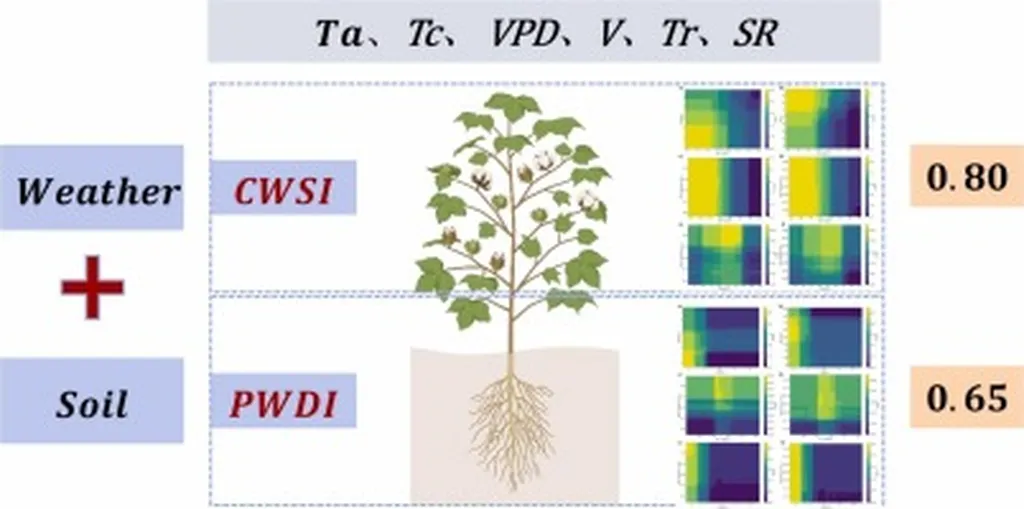In the heart of Xinjiang, where cotton fields stretch under the vast sky, a groundbreaking study is reshaping how farmers and agronomists diagnose and manage water stress in crops. The research, led by Hang Wang from the Institute of Environment and Sustainable Development in Agriculture at the Chinese Academy of Agricultural Sciences, leverages machine learning algorithms to predict critical water stress indices, offering a new lens through which to view crop water productivity.
The study, published in *Agricultural Water Management*, focuses on the Cotton Water Stress Characterization Index (CWSI) and the transpiration-based Plant Water Deficit Index (PWDI). These indices are pivotal for understanding how crops like cotton respond to water availability, a crucial factor in arid regions like Xinjiang. By accurately predicting these indices, farmers can make informed decisions about irrigation, potentially saving water and improving crop yields.
The research team evaluated the predictive performance of four machine learning algorithms using field experiment data collected over two years. The standout performers were tree-based models, specifically Random Forest (RF) and XGBoost. These models outperformed others in predicting CWSI and PWDI, providing a robust tool for water stress diagnosis.
“The accuracy of these predictions is a game-changer,” says Wang. “By understanding the key factors influencing CWSI and PWDI, we can develop more precise irrigation strategies that optimize water use and enhance crop productivity.”
The study identified key variables that significantly impact the indices. For CWSI, midday air temperature, leaf temperature, and vapor pressure deficit were the most influential factors. For PWDI, stem sap flow rate, transpiration rate, and solar radiation played crucial roles. These findings not only enhance our understanding of water stress in cotton but also provide actionable insights for farmers.
One of the most significant findings was the determination of optimal conditions for accurate predictions. For CWSI, the best predictions were made when midday air temperature was below 27°C and leaf temperature was below 27°C. For PWDI, optimal predictions were achieved when midday air temperature was above 27°C, root-zone soil water content was below 0.175 cm³/cm³, and solar radiation was below 400 W/m².
These thresholds are critical for developing targeted irrigation strategies. For instance, during the squaring and boll stages of cotton growth, the study suggests specific CWSI values of 0.79 and 0.80, respectively, while PWDI values remained consistent at 0.65 across stages. These insights can help farmers tailor their irrigation practices to the specific needs of their crops, ensuring optimal water use efficiency.
The commercial implications of this research are substantial. In an era where water scarcity is a growing concern, the ability to predict and manage water stress accurately can lead to significant savings in water usage and improved crop yields. This is particularly relevant for the cotton industry, which is a major consumer of water resources.
As the agriculture sector continues to evolve, the integration of machine learning algorithms into water management practices represents a significant step forward. The research by Wang and his team not only provides a powerful tool for diagnosing water stress but also sets the stage for future developments in precision agriculture.
By harnessing the power of data and advanced analytics, farmers and agronomists can make more informed decisions, ultimately leading to more sustainable and productive agricultural systems. The study’s findings, published in *Agricultural Water Management*, underscore the potential of machine learning in transforming agricultural practices and paving the way for a more water-efficient future.
As the agriculture sector continues to evolve, the integration of machine learning algorithms into water management practices represents a significant step forward. The research by Wang and his team not only provides a powerful tool for diagnosing water stress but also sets the stage for future developments in precision agriculture.
By harnessing the power of data and advanced analytics, farmers and agronomists can make more informed decisions, ultimately leading to more sustainable and productive agricultural systems. The study’s findings, published in *Agricultural Water Management*, underscore the potential of machine learning in transforming agricultural practices and paving the way for a more water-efficient future.

